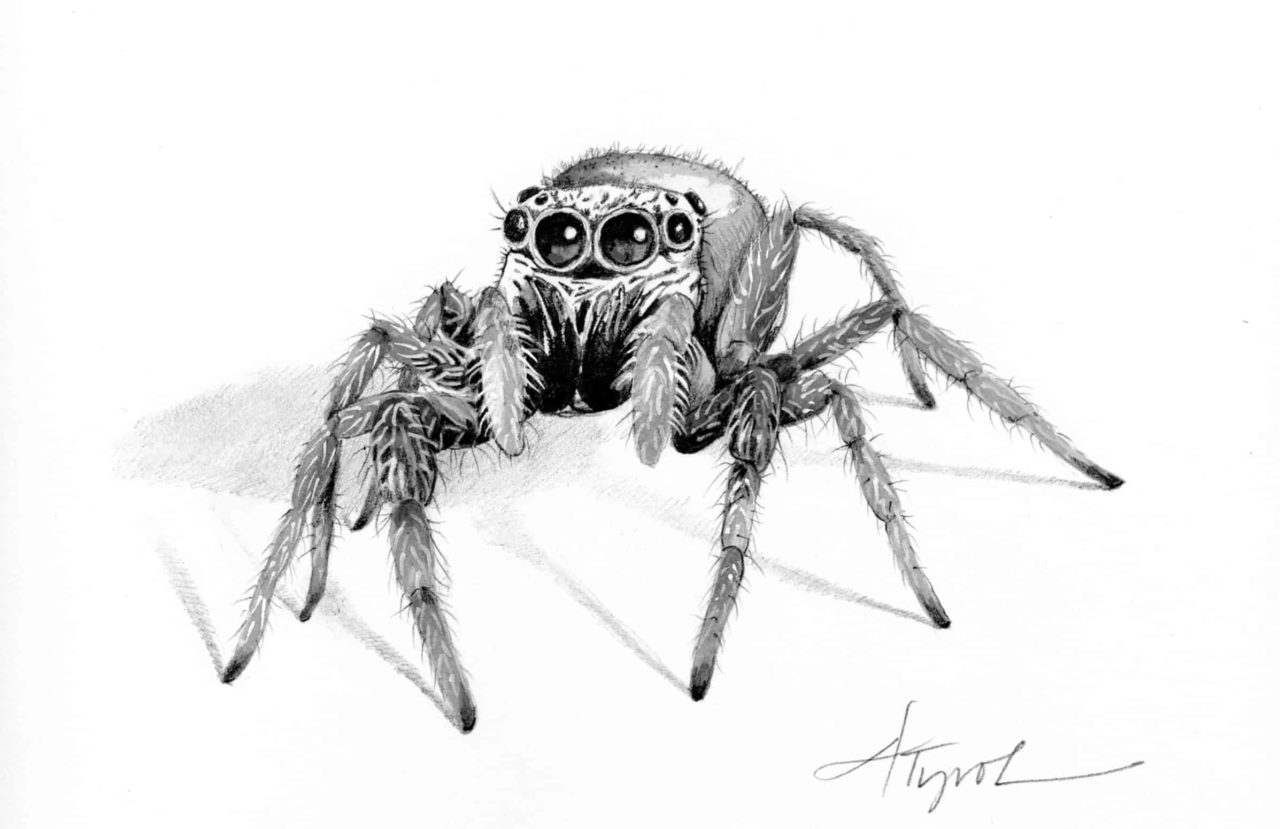The Outside Story
By Rachel Mirrus
Many of us avoid close encounters of the eight-legged kind, but if you’ve ever come eye to eye with a spider, you’ve probably noticed they have several more eyes than we do: most have four pairs. What do they do with so many eyes? Well, it depends on the spider.
Spider vision is very different across families of spiders, according to Elizabeth Jakob, a biology professor at the University of Massachusetts at Amherst who studies spiders and how they see. Web building spiders, like the big gray orb-weaving barn spiders who love porches and sheds, have terrible vision despite their many eyes. Instead, they rely on touch and vibration to navigate their world. Conversely, hunting spiders, including the jumping spiders Jakob studies, have excellent vision, optimized for specific challenges.
Jumping spiders, who are all members of the family Salticidae, are active day hunters and get their common name from their amazing jumping ability. I’ve spotted jumping spiders hunting in places as diverse as in the grass of a meadow, up a cliff face, and on my deck. Their vision is just as impressive as their mighty leaps; jumping spiders can see in great detail as well as in color.
Jakob’s study subject is the common and surprisingly adorable bold jumping spider. Bold jumpers are large for this spider family, measuring up to 2/3 of an inch long. They appear fuzzy, are typically black with white markings, and they have iridescent green chelicerae, or mouthparts. When they aren’t in the lab being studied, they prefer green spaces like fields, landscaped yards, or sparse woodland. These spiders have the expected four pairs of eyes: two pairs looking from the side and back of their head that can alert a spider to something sneaking up on it, one tiny pair of unknown function, and one pair like huge headlights dominating the front of their face – and adding to their cuteness factor.
Those headlight eyes are built to see details. The lens of each eye is part of the exoskeleton of the spider’s head, and it doesn’t move. Behind each lens is a long tube inside the spider’s head. At the end of these tubes are tiny retinas packed with photoreceptors, which provide excellent visual acuity. The spider moves the tube using internal muscles, kind of like aiming a telescope. This means jumping spiders can sit motionless and still move their field of view, an invaluable trick for stalking prey.
Also similar to a telescope, the field of view for those big eyes is very small. To use them effectively, the spider needs to know where to point them, and this is where the other eyes come in. The pairs on the side of their head are motion detectors. Whenever those eyes pick up movement, the spider points its eye tubes towards it for a closer look.
Essentially, those side and back eyes act much like our peripheral vision, and the spiders’ big front eyes act like our fovea, the high-acuity spot in our retinas. When we see something out of the corner of our eye, we react by turning to look at it with the high-acuity part of our eyes, much like a jumping spider does. And like us, jumping spiders can see color, although how and which colors depends on the species.
Jakob is fascinated by how such a tiny animal can achieve high quality vision. “It’s impressive,” she said. “Our eyeballs are bigger than the entire spider.” While we use one pair of eyes, however, jumping spiders combine information from all four pairs of eyes to see. Her ongoing research is looking at how spiders’ tiny brains can stitch the visual input from all those eyes into one sense of sight.
With four pairs of eyes to work with, each family of spiders has distinctive eye arrangements. So distinct, in fact, that spider experts rely on the arrangement of a spider’s eyes, more than any other characteristic, to identify different species. If you ever do have a close encounter of the spider kind and want to learn what type of spider you’ve met, don’t forget to lean in for a close look at its eyes!
Rachel Mirus lives and writes in Duxbury, Vermont. The illustration for this column was drawn by Adelaide Tyrol. The Outside Story is assigned and edited by Northern Woodlands magazine and sponsored by the Wellborn Ecology Fund of New Hampshire Charitable Foundation: nhcf.org.





